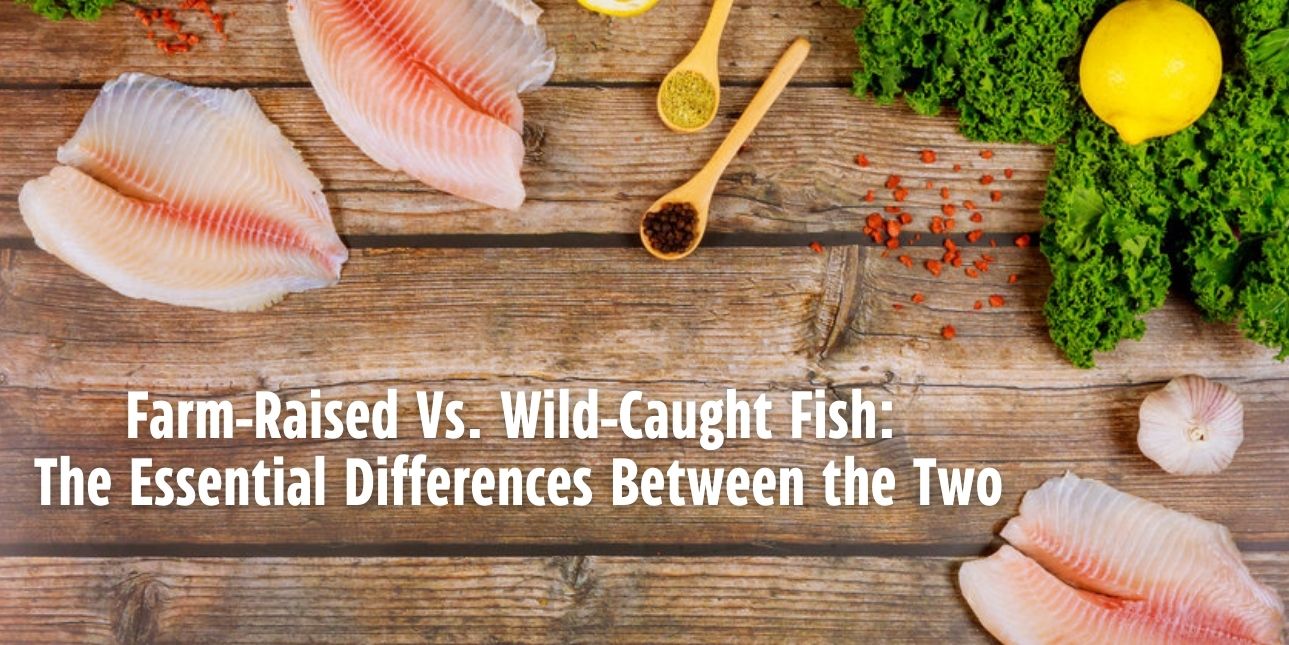
Patrons and food connoisseurs across the globe prefer seafood over other types of meats. Seafood provides essential nutrients that pork and chicken are unable to deliver. Seafood is lighter and healthier than other meat types. There has been a surge in demand for seafood globally. Currently, many fish populations are on the verge of extinction because of overfishing. The growing demand for seafood has led businesses to opt for farm-raised fish. Farm-raised options are more sustainable than wild-caught fish.
In this article, we discuss what wild-caught fish are, the pros and cons of wild-caught fishing, why wild-caught fish is better, and the contamination levels in farm-raised catfish and wild catfish. We also discuss the reasons why farm-raised fish can be a better option, the differences between farm-raised fish vs. wild-caught fish, and the sustainability of farm-raised vs. wild-caught fishing.
What Are Wild Caught Fish?
Wild-caught fish refer to shellfish, fish, and various types of seafood that are mostly harvested from oceans, rivers, and lakes. Wild-caught fish have a natural lifestyle and are not raised in captivity. Wild-caught fishing has been part of cultures for thousands of years. The recent surge in wild-caught fishing has been because of climate change and the high demand for wild-caught fish.
Alaskan salmon, Atlantic mackerel, sockeye salmon, and sardines are some popular wild-caught fish. Proper storage is crucial to preserving wild-caught fish. For storing wild-caught fish reliably, you will need good quality walk-in coolers.
The Pros and Cons of Wild-Caught Fish
Pros of Wild-caught Fish
Here, we list some pros of wild-caught fish:
- Wild-caught fish tastes better: Wild-caught fish are more flavorful than farm-raised fish. The diet of wild-caught fish is more diverse than farm-based fish.
- Wild-caught fish have leaner meat: Wild-caught fish are constantly moving, making them leaner than farm-raised fish. The meat is less fatty, which makes it healthier.
- Better color: When we consider wild-caught fish vs. farm-raised fish, wild-caught fish have better color because of their versatile diet. For example, wild-caught salmon looks better than regular salmon.
Cons of Wild-caught Fish
There are some cons of wild-caught fish, as discussed below:
- Unsustainable: Wild fish populations are smaller, but demand is at the same level, which causes recurring issues. The result is the current level of wild-caught fishing is damaging to the environment. The process is hurting oceans and sea creatures.
- Wild-Caught Fish Is Not Fresh: Wild-caught fish needs to travel long distances, so freshness is compromised. The level of freshness of the fish can also alter taste.
- Higher Levels of Mercury in Wild-Caught Fish: The mercury levels of wild-caught fish can be worrying. Even though the levels of mercury are too low for humans to be affected, wild-caught fish have higher levels of mercury than farm-raised fish.
- Increasing Prices: As the wild-caught fish population shrinks, the price is continuously increasing because of global demand. Wild-caught fish will be economically unviable over time.
Why Is Wild-Caught Fish Better?
Many have asked, ‘Is wild-caught better than farm-raised?’. Some believe wild-caught fish is healthier than farm-raised fish. They hold more nutritional value than farm-raised fish because of their varied diet. Farm-raised fish eat the same food, which leads to stagnated nutritious growth. The quality of the food content for farm-raised fish can depend on the fish farm. The diet can be premium fish food or low-quality fish food. Wild-caught fish are also not prone to diseases and illnesses as they live naturally and not in an artificial environment. Some fish farms have insufficient quality control procedures and practices. They are both harmful to consumers and the environment. Farm-raised fish also carry various pesticides and PCBs that are used to control diseases in fish farms. Wild-caught fish are more immune to diseases.
Consuming wild-caught fish is considered healthier worldwide. Additionally, wild-caught fish has less saturated fat than farm-raised fish. Some wild-caught fish have higher levels of omega-3, which helps in brain development and functioning. Some wild-caught fish have higher levels of other nutrients as well.
Farm-Raised Catfish Vs. Wild: Contamination Levels
Farm-raised catfish have more contamination levels than wild-caught catfish. Some fish farm owners use various drugs to speed up the growth process. Farmed catfish are also introduced to antibiotics for disease resistance and to prevent illness.
Most wild-caught fish, farm-raised fish, and catfish contain specific amounts of mercury, but the levels are primarily non-significant. Larger fish species like sharks, tuna, and swordfish have higher levels of mercury than smaller species.
Is Farm-raised Fish Better for the Environment?
Farm-raised fish is mostly cultivated in net pens near the shore. Farm-raised fish are more sustainable than wild-caught fish. They can help reduce the dependency on wild-caught fish. Farm-raised fish are also known as ‘ocean-raised fish’. Sometimes farm-fishing is also referred to as ‘aquaculture’.
Some other pros of farm-raised fish are:
- Easily Available: Most farm-raised fish are readily available throughout the year. You can cultivate various types of farm-raised fish.
- Economical: Farm-raised fish are also cheaper than wild-caught fish. They are less cost-intensive and easy to harvest, process, and ship. You can store farm-raised fish in high-quality refrigeration equipment to prolong their shelf life.
- Sustainable: Globally, farm-raised fishing is considered a sustainable way of fishing. Over time, you can generate more revenue with farm-raised fish for your foodservice establishment. You can also generate more engagement with customers who want to eat healthily.
Some popular farm-raised fish are American Atlantic salmon, Arctic char, oyster, rainbow trout, and tilapia.
Farm-Raised Fish Vs. Wild-Caught Fish
Farm-raised fish or wild-caught fish can be the perfect option for your business, depending on your location. The best type of fish for your establishment will mostly be locally sourced. For example, you will always prefer farm-raised fish available throughout the year that is cheaper than a wild-caught fish. Wild-caught fish is mostly caught during fishing seasons, frozen for storage and transport, and shipped across the globe.
There are various pros and cons of wild-caught fish and farm-raised fish. The final choice will depend on your foodservice establishment’s needs and the prices of your dish. Make sure to research all the pros and cons of farm-raised vs. wild-caught fish to make your final choice. Consider exploring sustainable alternatives for your foodservice establishment.
Sustainability of Farm-raised Vs. Wild-Caught Fish
Wild-caught fish and farm-raised fish are susceptible to various unsustainable practices. Wild-caught fish are mostly overfished, which can cause damage to the environment. Sustainability is also linked to efficient storage and transport. Some have inquired about how to prolong the shelf life of fish in commercial foodservice establishments and how to choose commercial refrigerators that are perfect for farmed and wild-caught fish; make sure to click on the link for the best storage options for fish at your establishment.
While comparing wild-caught fish vs. farm-raised fish, you will find advantages and disadvantages for both options. Farm-raised fish can provide excellent quality fish if farmed responsibly. They are more consistent in color, texture, size, and flavor. Wild-caught fish have leaner meat and are healthier but can go extinct because of overfishing.










